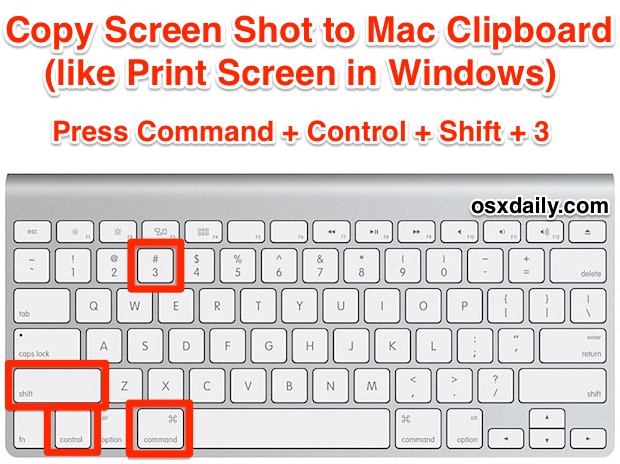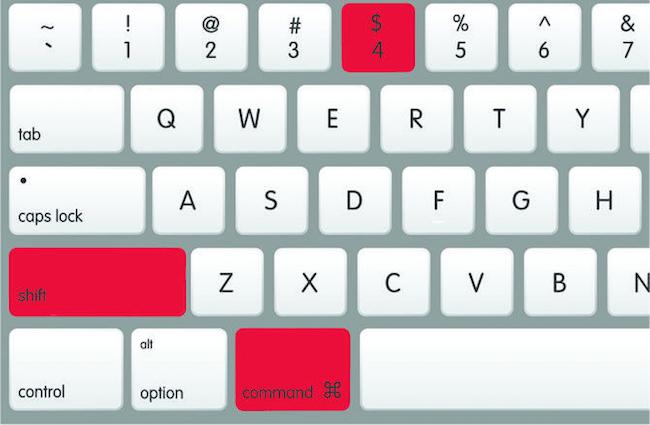Keyboard Shortcut For Screenshot Mac
If you've upgraded to macOS Mojave or later, you can use the Screenshot app to take all types of screenshots, or make video recordings of your screen. You can open Screenshot by pressing Shift-Command (⌘)-5, or use Spotlight to find and open the app.
- Keyboard Shortcut Screenshot Macos
- Shortcut For On Screen Keyboard
- Mac Shortcuts Cheat Sheet Pdf
- Control Keys For Screen Shot
How to Screenshot your Entire Screen using Keyboard Shortcut? You need to Press SHIFT along with COMMAND key and 3 at the same time. (COMMAND KEY- The key with the Apple and/or clover-leaf (⌘) symbol (usually next to the space bar. Jun 28, 2017 Screenshot on MAC or Screenshot in MAC is the topic we discuss in this article. Generally a screenshot or a screen capture is the image of our display captured using different commands, keyboard shortcuts etc. Screenshots on MAC or Screen captures on MAC. On a Mac, you can take screenshots with a few quick keyboard shortcuts. But Mac OS X also includes more powerful screenshot tools, too. Here are some of the many ways you can get a screenshot on OS X. Let’s start with those keyboard shortcuts. To take a screenshot of your entire screen, press Command+Shift+3. Oct 18, 2019 Mac keyboard shortcuts. On keyboards made for Windows PCs, use the Alt key instead of Option, and the Windows logo key instead of Command. Some keys on some Apple keyboards have special symbols and functions, such as for display brightness, keyboard brightness. May 19, 2017 On a Mac, you might hear the language of how to screen capture or how to screenshot. Screenshot – Screen Capture – Print Screen in Windows on Mac. To capture the entire screen simply press Function (fn) + Shift + F11. To capture the front most window press Option (alt) +.
Other keyboard shortcuts, such as Shift-Command-3 and Shift-Command-4, continue to work in all versions of macOS. Smule for macbook.
Jan 29, 2016 For a complete, master list of Windows 10 keyboard shortcuts, you'll want to peruse this master list we've compiled. Mac Shortcuts and their Windows.
Capture the entire screen
Press Shift-Command-5 or Shift-Command-3 as described below.
In macOS Mojave or later
- Press Shift-Command-5 on your keyboard to see the onscreen capture controls:
- Click Capture Entire Screen . The pointer changes to a camera .
- Click anywhere on any screen to capture the screen of that display, or click Capture to capture the screen of every display.
- A thumbnail of the screenshot briefly appears in the corner of your screen. Interact with the thumbnail to edit the screenshot, move it, or take other actions. Or wait for the screenshot to appear on your desktop.
Keyboard Shortcut Screenshot Macos
In all macOS versions
- Press Shift-Command-3 to capture the screen of every display.
- Find the screenshot on your desktop.
Capture a window
Press Shift-Command-5 or Shift-Command-4 as described below.
In macOS Mojave or later
- Press Shift-Command-5 to see the onscreen capture controls.
- Click Capture Selected Window . Your pointer changes to a camera .
- Click a window to capture that window.
To exclude the window's shadow from the screenshot, press and hold the Option key while you click. - A thumbnail of the screenshot briefly appears in the corner of your screen. Interact with the thumbnail to edit the screenshot, move it, or take other actions. Or wait for the screenshot to appear on your desktop.
In all macOS versions
- Press Shift-Command-4.
- Press the Space bar. The pointer changes to a camera .
- Click a window to capture that window.
To exclude the window's shadow from the screenshot, press and hold the Option key while you click. - Find the screenshot on your desktop.
Capture a selected portion of the screen
Press Shift-Command-5 or Shift-Command-4 as described below.
In macOS Mojave or later
- Press Shift-Command-5 to see the onscreen capture controls.
- Click Capture Selected Portion .
- Drag to select an area of the screen to capture. To move the entire selection, drag from within the selection.
- Click Capture.
- A thumbnail of the screenshot briefly appears in the corner of your screen. Interact with the thumbnail to edit the screenshot, move it, or take other actions. Or wait for the screenshot to appear on your desktop.
In all macOS versions
Shortcut For On Screen Keyboard
- Press Shift-Command-4.
- Drag to select the area of the screen to capture. To move the entire selection, press and hold Space bar while dragging.
- After you release your mouse or trackpad button, find the screenshot on your desktop.
Capture a menu
Press Shift-Command-5 or Shift-Command-4 as described below.

In macOS Mojave or later
- Click the menu to reveal its contents.
- Capture the menu using either of these methods, which use Shift-Command-5:
- Capture a window (the menu is treated like a window).
- Capture a selected portion of the screen that includes the menu.
In all macOS versions
- Click the menu to reveal its contents.
- Press Shift-Command-4.
- Drag to select the area of the menu to capture, then release your mouse or trackpad button to capture that area.
- Or press Space bar to change the pointer to a camera , then click the menu to capture it.
- Find the screenshot on your desktop.

Capture the Touch Bar
If you have a Mac with a Touch Bar and macOS Sierra 10.12.2 or later, press Shift-Command-6 to capture what is currently displayed on the Touch Bar. Then find the screenshot on your desktop.
You can also customize the Control Strip region of your Touch Bar to include a Screenshot button.
Use the screenshot thumbnail
When you take a screenshotin macOS Mojave or later, a thumbnail of the screenshot appears briefly in the lower-right corner of your screen.
- Take no action or swipe the thumbnail to the right: The screenshot is automatically saved to your chosen save location, which by default is the desktop.
- Control-click the thumbnail to choose more actions, such as change the default save location, open the screenshot in an app, or delete the screenshot without saving it.
- Drag the thumbnail to move the screenshot to another location, such as to a document, an email, a Finder window, or the Trash.
- Click the thumbnail to open the screenshot. You can then use the markup tools in the toolbar to crop, rotate, annotate, and take other editing actions. Or click the share button to share the screenshot.
Mac Shortcuts Cheat Sheet Pdf
Clicking the thumbnail opens it in editing view. Hover your pointer over each button in the toolbar to see its function.
Control Keys For Screen Shot
If you don't want the thumbnail to appear, click Options in the onscreen controls, then use the ”Show Floating Thumbnail” option to change the setting.
Full Specifications What's new in version 10.8.6. Divx pro 10 download.
Learn more
- Screenshot controls in macOS Mojave or later are provided by the Screenshot app, which is in the Utilities folder of your Applications folder. This app replaces the Grab app from earlier versions of macOS.
- By default, screenshots are saved with the name ”Screen Shot date at time.png”.
- To cancel taking a screenshot, press the Esc (Escape) key before clicking to capture.
- To store the screenshot in the Clipboard instead of saving it, press and hold the Control key while you click to capture. You can then paste the screenshot into a document, message, or other location. Using Universal Clipboard, you can even paste it on another Apple device.
- You can open screenshots with Preview, Safari, or other apps that can edit or view images. Preview can export to a different format, such as JPEG, PDF, or TIFF.
- Some apps, such as DVD Player, might not let you take screenshots of their windows.